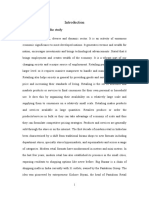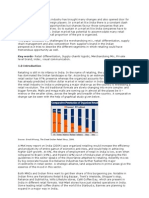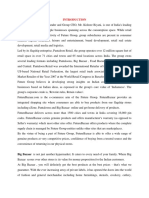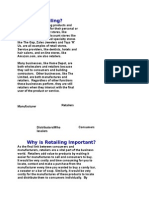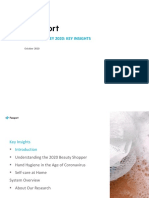Assignment 3
Uploaded by
Sudhanva VijayAssignment 3
Uploaded by
Sudhanva VijayFuture of organized retailing in India challenges and opportunities
Organised retailing, absent in most rural and small towns of India in 2011, refers to trading activities undertaken by licensed retailers, that is, those who are registered for sales tax, income tax, etc. These include the publicly-traded supermarkets, corporatebacked hypermarkets and retail chains, and also the privately owned large retail businesses. Unorganised retailing, on the other hand, refers to the traditional formats of low-cost retailing, for example, the local mom and pop store, owner manned general stores, paan/beedi shops, convenience stores, hand cart and pavement vendors, etc. As organized retailers attempt to take over the Indian market, however, they must be mindful of the unique status of retail in the country. Retail in the country has been dominated by millions of unorganized retailers who have used consumer proximity and home-delivery as their operating ideals to cater to the Indian consumer that has become accustomed to this convenience. Let s consider some of the factors that could affect the future of organized Retail in India. Consumers He who understands the Indian consumer the best will win in the end. The Indian consumer is hard to pin down. The dimensions to deal with include class, education, language, caste and local customs in addition to the standard marketing dimensions adopted from the West. Merchandising The art-science of deciding what to sell where, at what price and when. The retailers that understand the Indian consumers and provide the right products at the right price will beat the competition. Talent The retailers that are able to retain their talent and provide them with growth opportunities will easily gain an upper hand in running a successful operation in India. Real Estate This is a huge concern in India where quality real estate has become too expensive for many retailers to run a successful operation in cities. This is especially true for mass merchandise/discount retailers who operate on razor-thin margins. The acquisition of cheap leases in prime areas could decide whether a retailer becomes profitable at all or not. Another strategy is to expand in smaller towns and villages where real estate is still affordable and purchasing power is not as bad as one might think. Supply Chain The supply chain infrastructure needs to be built from the ground up in India. This could easily affect the balance sheet of any retailer planning to start operations in India. Inadequate highways, the absence of cold storage facilities, an underdeveloped supply chain, limitless bureaucracy and the lack of regulations created a situation where the local corner-stores and hawkers thrived. What was the street-vendors gain will be a major hurdle
for large-scale organized retailers. They will have to demonstrate unprecedented innovation, adaptation and experimentation to succeed in the Indian retail industry. Policy Although FDI is allowed, if the examples of Brazil or China are taken into account, we will see a lot of consolidation with a few (6-8) large players remaining and several smaller niche players. Retail is a highly localized business (local preferences, local talent), so there is no guarantee that a foreign player will do better than an Indian player, as evidenced by Walmart s failures in Germany and Korea.
So what is this lure of organized retail? The country s staggering economic growth of around 8% resulted in major shifts in the Indian class structure with higher incomes leading to the growth of the Indian middle-class. This is a middle-class that is aware of the standards of living in other countries thanks to exposure through the media and internet. Unlike their forefathers they have decided to adopt a Spending approach to improve their standard of living rather than a Saving approach. With an estimated 400 million shoppers and growing, organized Indian retail s target population is larger than that of the entire United States. Another important factor to consider is the effect of existing organized retail in India in fueling consumerism. New malls and supermarkets with their modern decors and multiple products are enticing Indian consumers. This is one of the most direct factors responsible for the mentality change of the Indian consumer. As people see their relatives, friends, neighbors shopping at these new establishments, they are bound to jump on the bandwagon as well. The consumer of today, at least what the multinationals are targeting, is popularly known as the aspiring India the middle income segment which is growing faster than ever. But these consumers not only have price and quality on their minds but also the fact that their brands effectively reflect their local environment and are consonant with their life style. And this is where the foreign multinationals coming into the Indian consumer market have to pay attention. Selling global brands in India at global prices is a road to perdition. Companies who have tailored their products to the Indian environment and customer have reaped high rewards. The Indian consumer s change in attitude is going to manifest itself into rewards for the organized retail industry. At the same time, Indians will find it hard to give up their old habits of shopping at the local corner-store or buying goods from the street-vendor. Hence, a proper mix of these two thoughts seems like the idea solution. Big Bazaar seems to have been built with this idea in mind. But then that is just a start. With experience and money, has to have the sense of appeal for the Indian consumer as well and the future for organized retail looks good.
Critical assessment of Tesco Club Card and its key factors for success and comments on whether it could work in India
Tesco Club Card is the loyalty card of leading British supermarket chain Tesco. The Clubcard scheme operates in the UK, Ireland, Poland and several other countries, and in the UK market in particular has been highly successful, with over 15 million members as of 2010. The data gathering for the loyalty program starts with a typical application which might ask for some basic demographic information such as address, age, gender, the number of members in a household and their ages, dietary habits.. Against this basic information, purchase history is appended. This includes the goods shopped for, and also information such as visit history, both to stores and online. Next, a number of summary attributes are also computed. These include share of wallet information, information on frequency and duration of visits. Also information on customer preferences and tastes, as determined by some clever cluster analysis based on purchase history of specific fast-moving products. To summarize, Tesco maintains information about: 1. Customer demographics 2. Detailed shopping history 3. Purchase tastes, frequency, habits and behavior 4. Other individual level indicators obtained from public sources
Some of the reasons for success and their achieved benefits are as follows: y Probably a reason behind Tesco s success with Clubcard can be attributed to the fact that Tesco has also established relationships and partnerships with popular companies like Powergen that supplies electricity and gas, Beefeater restaurants, Avis car-hire, Marriott Hotels, National Tyres, Johnsons dry cleaners, mfi etc. Therefore customers can earn points using Clubcard not only at Tesco, but at stores of any of these companies. Further the points can also be earned by purchasing fuel at Tesco petrol stations and by using their online shopping to buy music, books, flowers and electrical goods. Even the points can be earned by paying with Tesco Credit Card or by using Tesco Mobile, Tesco Home Phone and selected Tesco Financial Products. This means that customers can easily and frequently accumulate the minimum 150 points and get price-off vouchers. Other loyalty cards have also failed in the past because the retailers did not had sufficient partnerships with other popular companies and so for a customer it took many months to collect minimum points and get vouchers. Thus slowly customers lost their interest in such schemes. Tesco s Clubcard in contrast has managed to maintain interest in the customers.
Loyalty: First clear benefit is customer loyalty and the increased spend that comes from a customer moving most of their purchases on to Tesco. The loyalty program incentivizes customers to steer a greater share of their monthly grocery spend onto Tesco. This is a clear objective of any loyalty program and Tesco delivers on the business objective brilliantly. Tesco does this by offering vouchers on associated products - so if a family is buying infant formula, it is quite a straightforward decision to offer them discounts on diapers and get the customer to move that part of the purchase also to Tesco. Cross sells: Most immediate extension from increasing spending within one product category is cross-selling across product families. So an example of this would be (from the previous example) marketing a college-fund financial product to a family that has newly got into infant food and diapers purchases. An alternative would be to see Disney Cruises to a family with small children. In this case, Tesco would not only collect a channel fee from Disney for selling their cruises through its site but also a premium for being demonstrably targeted in their marketing.
Will the model work in India? Loyalty programs are not unknown in India. Payback India (formerly i-mint) is India's largest coalition loyalty program, with 10 million members and 1500 network partners, with 120 billion INR of sales generated through i-mint-cards in 2009. Hero Honda's passport program claims over 3 million members. BPCL's PetroBonus fuel card program has 2 million members. Indian Oil's fleet card program XTRAPOWER and retail program XTRAREWARDS claim a combined customer base of 3 million. The Maruti Suzuki AutoCard, launched in association with Citibank and Indian Oil had 370,000 cardholders as in October 2008. Kingfisher Airlines FFP King Club had 2 million members as in October 2010. Shopper's Stop has been offering a loyalty programme called First Citizen for well over a decade for regular customers. Other retailers like Lifestyle (The inner Circle loyalty Programme) & Reliance Retail also have their own loyalty programmes. The Tesco club card would work provided it offers the same wide range of products and offerings. One of the advantages it has in the UK and other places is Tesco s presence in areas of consumer purchase beyond grocery and everyday goods. It would gain more popularity due to its tie ups with other organizations. Sticking to just Tesco stores would narrow it down unnecessarily. Here the entire debate of how ready Indian consumers are for organized retail would again fall into place. In order to achieve the massive success and the large numbers, Tesco would have to look beyond the usual category of products and companies it deals with.
Another problem is the large amount of shopping that is done at unorganized outlets. This is not only to do with food and grocery, but even for clothes and entertainment (small theatres or road side fairs). Alluring the Indian consumer with rewards that are available at stores beyond his reach would not be easy. The advantage is that the first step of becoming a member is free. It doesn t come with a threshold amount of purchase. That would certainly appeal to the consumers and at least get them to consider the store as a point of purchase.
You might also like
- _OceanofPDF.com_Own_Your_Money_-_Michela_AlloccaNo ratings yet_OceanofPDF.com_Own_Your_Money_-_Michela_Allocca211 pages
- FREE VERSION HighTicketElites E-Commerce E-BookNo ratings yetFREE VERSION HighTicketElites E-Commerce E-Book109 pages
- Entry Strategy For Lilliput With Detailed AnalysisNo ratings yetEntry Strategy For Lilliput With Detailed Analysis18 pages
- Customer Relationship Management BigBazarNo ratings yetCustomer Relationship Management BigBazar50 pages
- Definition of Retail: Problems With The Payment SystemNo ratings yetDefinition of Retail: Problems With The Payment System25 pages
- Global Retailing Scenario and The Indian Retail100% (1)Global Retailing Scenario and The Indian Retail7 pages
- Selling On A Shoestring: The Paradox of More: Magic or Misery?No ratings yetSelling On A Shoestring: The Paradox of More: Magic or Misery?1 page
- Indian Retail Industry - Opportunities, Challenges, and StrategiesNo ratings yetIndian Retail Industry - Opportunities, Challenges, and Strategies4 pages
- A Study of Customer Relationship Management at Big Bazaar"25% (4)A Study of Customer Relationship Management at Big Bazaar"68 pages
- Research Question:: Status of IT Use in Retail Sector of Pakistan: Problems and PossibilitiesNo ratings yetResearch Question:: Status of IT Use in Retail Sector of Pakistan: Problems and Possibilities12 pages
- Forbes India Magazine - Decoding The Detail in RetailNo ratings yetForbes India Magazine - Decoding The Detail in Retail14 pages
- Customer Relationship Management in Retail Sector Big Bazaar100% (1)Customer Relationship Management in Retail Sector Big Bazaar57 pages
- Case - I What Lies in Store For The Retailing Industry in India?No ratings yetCase - I What Lies in Store For The Retailing Industry in India?9 pages
- Promotional Strategy of Big Bazaar: An Insight: T. Surulipal K. BaranidharanNo ratings yetPromotional Strategy of Big Bazaar: An Insight: T. Surulipal K. Baranidharan4 pages
- Mid Term Project Report Retail Marketing in India & Its Future Prospects 10 May 2016No ratings yetMid Term Project Report Retail Marketing in India & Its Future Prospects 10 May 20169 pages
- Key Words-Retail Differentiation, Supply Chain& Logistic, Merchandising Mix, PrivateNo ratings yetKey Words-Retail Differentiation, Supply Chain& Logistic, Merchandising Mix, Private10 pages
- Analysis of Expansion and Diversification in Retail Sector 01No ratings yetAnalysis of Expansion and Diversification in Retail Sector 014 pages
- The 86% Solution (Review and Analysis of Mahajan and Banga's Book)From EverandThe 86% Solution (Review and Analysis of Mahajan and Banga's Book)No ratings yet
- The Art of Retail Buying: An Insider's Guide to the Best Practices from the IndustryFrom EverandThe Art of Retail Buying: An Insider's Guide to the Best Practices from the IndustryNo ratings yet
- The Soul of the New Consumer (Review and Analysis of Windham and Orton's Book)From EverandThe Soul of the New Consumer (Review and Analysis of Windham and Orton's Book)No ratings yet
- Industry Analysis Report - E-Commerce SectorNo ratings yetIndustry Analysis Report - E-Commerce Sector33 pages
- 2 Summative Test in General Physics 1: Nueva Vizcaya General Comprehensive High SchoolNo ratings yet2 Summative Test in General Physics 1: Nueva Vizcaya General Comprehensive High School3 pages
- Data Analysis and Interpretation: Table.1 Age of The RespondentNo ratings yetData Analysis and Interpretation: Table.1 Age of The Respondent24 pages
- Beauty Survey 2020: Key Insights: October 2020No ratings yetBeauty Survey 2020: Key Insights: October 202031 pages
- 378 High Frequency Words in IELTS ListeningNo ratings yet378 High Frequency Words in IELTS Listening12 pages
- Open Course Ba5Opt22 (A) : Brand ManagementNo ratings yetOpen Course Ba5Opt22 (A) : Brand Management34 pages
- A. Choose The Correct Verb From The List Below To Complete The Following Sentences. Put The Verb in The Past Perfect Tense (Had & Past Participle)No ratings yetA. Choose The Correct Verb From The List Below To Complete The Following Sentences. Put The Verb in The Past Perfect Tense (Had & Past Participle)3 pages
- Marketplace Business Models - MultiMerchNo ratings yetMarketplace Business Models - MultiMerch20 pages
- Why Did Gateway Choose Not To Carry Any Finished-Product Inventory at Its Retail Stores?No ratings yetWhy Did Gateway Choose Not To Carry Any Finished-Product Inventory at Its Retail Stores?8 pages
- Entry Strategy For Lilliput With Detailed AnalysisEntry Strategy For Lilliput With Detailed Analysis
- Definition of Retail: Problems With The Payment SystemDefinition of Retail: Problems With The Payment System
- Selling On A Shoestring: The Paradox of More: Magic or Misery?Selling On A Shoestring: The Paradox of More: Magic or Misery?
- Indian Retail Industry - Opportunities, Challenges, and StrategiesIndian Retail Industry - Opportunities, Challenges, and Strategies
- A Study of Customer Relationship Management at Big Bazaar"A Study of Customer Relationship Management at Big Bazaar"
- Research Question:: Status of IT Use in Retail Sector of Pakistan: Problems and PossibilitiesResearch Question:: Status of IT Use in Retail Sector of Pakistan: Problems and Possibilities
- Forbes India Magazine - Decoding The Detail in RetailForbes India Magazine - Decoding The Detail in Retail
- Customer Relationship Management in Retail Sector Big BazaarCustomer Relationship Management in Retail Sector Big Bazaar
- Case - I What Lies in Store For The Retailing Industry in India?Case - I What Lies in Store For The Retailing Industry in India?
- Promotional Strategy of Big Bazaar: An Insight: T. Surulipal K. BaranidharanPromotional Strategy of Big Bazaar: An Insight: T. Surulipal K. Baranidharan
- Mid Term Project Report Retail Marketing in India & Its Future Prospects 10 May 2016Mid Term Project Report Retail Marketing in India & Its Future Prospects 10 May 2016
- Key Words-Retail Differentiation, Supply Chain& Logistic, Merchandising Mix, PrivateKey Words-Retail Differentiation, Supply Chain& Logistic, Merchandising Mix, Private
- Analysis of Expansion and Diversification in Retail Sector 01Analysis of Expansion and Diversification in Retail Sector 01
- Shopper Marketing 101: Making Brand Shopper ReadyFrom EverandShopper Marketing 101: Making Brand Shopper Ready
- The 86% Solution (Review and Analysis of Mahajan and Banga's Book)From EverandThe 86% Solution (Review and Analysis of Mahajan and Banga's Book)
- Retail Success Blueprint The Smart Retailer’s GuideFrom EverandRetail Success Blueprint The Smart Retailer’s Guide
- The Art of Retail Buying: An Insider's Guide to the Best Practices from the IndustryFrom EverandThe Art of Retail Buying: An Insider's Guide to the Best Practices from the Industry
- The Soul of the New Consumer (Review and Analysis of Windham and Orton's Book)From EverandThe Soul of the New Consumer (Review and Analysis of Windham and Orton's Book)
- 2 Summative Test in General Physics 1: Nueva Vizcaya General Comprehensive High School2 Summative Test in General Physics 1: Nueva Vizcaya General Comprehensive High School
- Data Analysis and Interpretation: Table.1 Age of The RespondentData Analysis and Interpretation: Table.1 Age of The Respondent
- A. Choose The Correct Verb From The List Below To Complete The Following Sentences. Put The Verb in The Past Perfect Tense (Had & Past Participle)A. Choose The Correct Verb From The List Below To Complete The Following Sentences. Put The Verb in The Past Perfect Tense (Had & Past Participle)
- Why Did Gateway Choose Not To Carry Any Finished-Product Inventory at Its Retail Stores?Why Did Gateway Choose Not To Carry Any Finished-Product Inventory at Its Retail Stores?




































